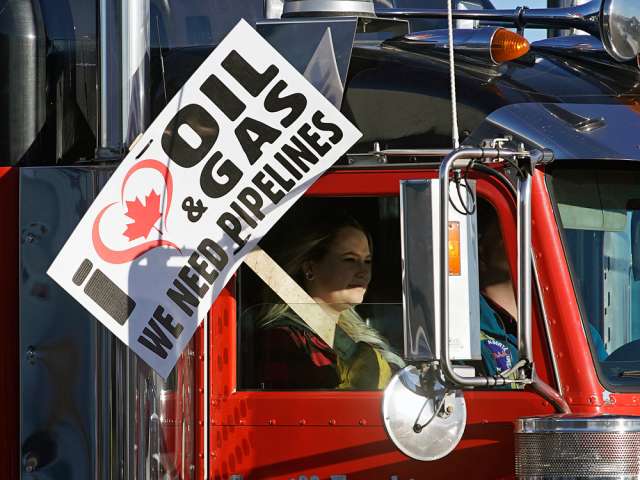
CALGARY — Oil investors are grateful the no-good, very-bad year they’ve just endured is over but, even after all the pain of 2018, hopes for a quick turnaround in the embattled sector are being challenged by a volatile outlook for crude prices in 2019.
This has been the worst year of my career
Eric Nuttall
“This has been the worst year of my career,” said Eric Nuttall, a partner and senior portfolio manager focused on the energy sector with Toronto-based Ninepoint Partners.
It’s how many oil investors have felt over the course of 2018. Analysts at Raymond James recently likened the red data all over trading screens to “the financial equivalent of a busy butcher’s floor” as the S&P/TSX Capped Energy Index fell 32 per cent between the beginning of October and the middle of December.
In early September, even before the sell-off began to accelerate, Nuttall wrote a note to clients that asked, “Will the most soul-sucking, emotionally draining, never ending, stress-inducing trade in history be worth it in the end?
Nuttall has continued to invest in energy stocks, including in the Canadian oil names, despite the fact other institutional investors and portfolio managers have “shunned” the space this year and that has resulted in “especially horrible” stock price drops.
Long-term oil and gas investors are hopeful the institutional money managers and generalists will be drawn back to the sector over the course of 2019. However, concerns about larger-than-expected oil supplies coupled with weaker global economic growth could prevent the re-entry of those investors, and the volatility in the market isn’t helping.
Some energy-focused funds, including at Toronto’s Kaoig Capital Partners Inc., have closed over the course of 2018 as equity prices tumbled and investors withdrew their holdings. Kaoig did not respond to a request for comment.
Others have endured painful losses or shrunk. London-based Andurand Commodities Fund, led by one of the oil market’s best-known hedge fund managers Pierre Andurand, dropped nearly 21 per cent as oil prices collapsed in October.
“We’ve been going through an exercise of price discovery to see how low prices can go before we see institutions come back. Now you have stocks trading at 50, 60 or 70 per cent discounts from where they were earlier this year,” Nuttall said.
He isn’t alone in thinking the market is over-sold. Many oil price forecasters agree the price of the global benchmark Brent crude, which hit a 52-week low of US$54.71 per barrel in December, should recover early in 2019.
“Financial flows and sentiment have gotten ahead of where fundamentals are,” said Ed Morse, global head of commodities research at New York-based Citigroup. Morse is forecasting Brent crude pricing of US$60 per barrel in the first quarter of next year.
“It’s really hard to call a bottom of anything,” Morse said, adding that there are risks to the oil price outlook.
Those include the potential for Organization of Petroleum Exporting Countries (OPEC) members not to adhere to the production cuts they agreed to in the last meeting of 2018, and the potential that the trade war between the U.S. and China could cause a further slowdown in global economic growth and oil demand.

Another potential risk to oil prices is the continuing growth in oil supplies in the U.S. because, Morse said, even at Brent prices of US$55 per barrel, oil production in the United States is able to grow by 1 million barrels per day. Ironically, that production growth will draw investors back to the sector.
“I do believe that if we get, and I suspect we will, a stabilization of Brent above US$60, we’ll have a re-entry of institutional investors into the E&P sector because it will be recognized that the cost structure has come down enough to allow companies to grow,” Morse said.
Ian Nieboer, a director at Calgary-based RS Energy Group, agreed that oil companies in the United States have been able to reduce their cost structures to a point where they can generate returns when oil is priced at US$55 per barrel.
“The irony is that for some operators — and probably the ones driving more of the growth — a price in the mid-50s, while not the best number they could ask for, does work for them. It’s not a moment of capital destruction,” Nieboer said.
In Canada, Scotiabank commodity economist Rory Johnston said he’s forecasting West Texas Intermediate oil prices of US$60 for 2019 and Western Canada Select oil prices about US$20 per barrel below the U.S. benchmark.
However, there could be some upside for Canadian prices because his estimates for the WCS/WTI differential may be too wide as refineries on the U.S. Gulf Coast are currently paying more than they have historically for heavy crude.
Still, most oil forecasters agreed there is so much volatility in the oil markets right now, it’s difficult to predict with certainty where oil prices and investing dollars will go.
“I think we’re in for a relatively volatile 2019. There’s a big split right now between the bullish and bearish narratives of the market,” Johnston said.
Ninepoint’s Nuttall said the market uncertainty around key variables like a potential slowdown in global economic growth is a concern for some investors, but added that low oil prices tend to drive oil demand.
He also said the carnage of 2018 has been so deep, that he believes oil equity prices are disconnected from reality. Despite a brutal year behind him, he’s optimistic for the year ahead.
“It really feels like December 2015, when stocks were really free falling like 5 or 6 per cent per day,” he said. “We rallied 143 per cent from the third week in January (2016) until the end of the year.”
“There is potential for the institutionals to come back just because the prices have gone so low, but maybe that’s just my optimistic bent,” Nuttall said.
With a file from Bloomberg
• Email:
You can read more of the news on source
